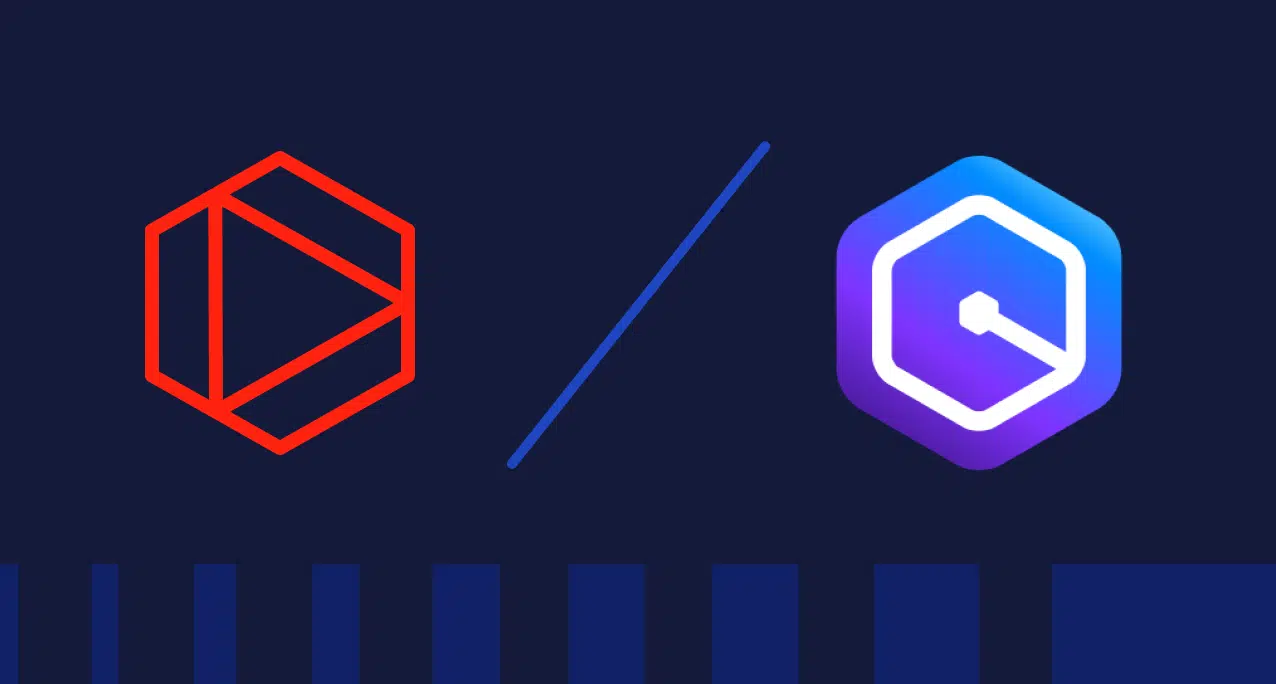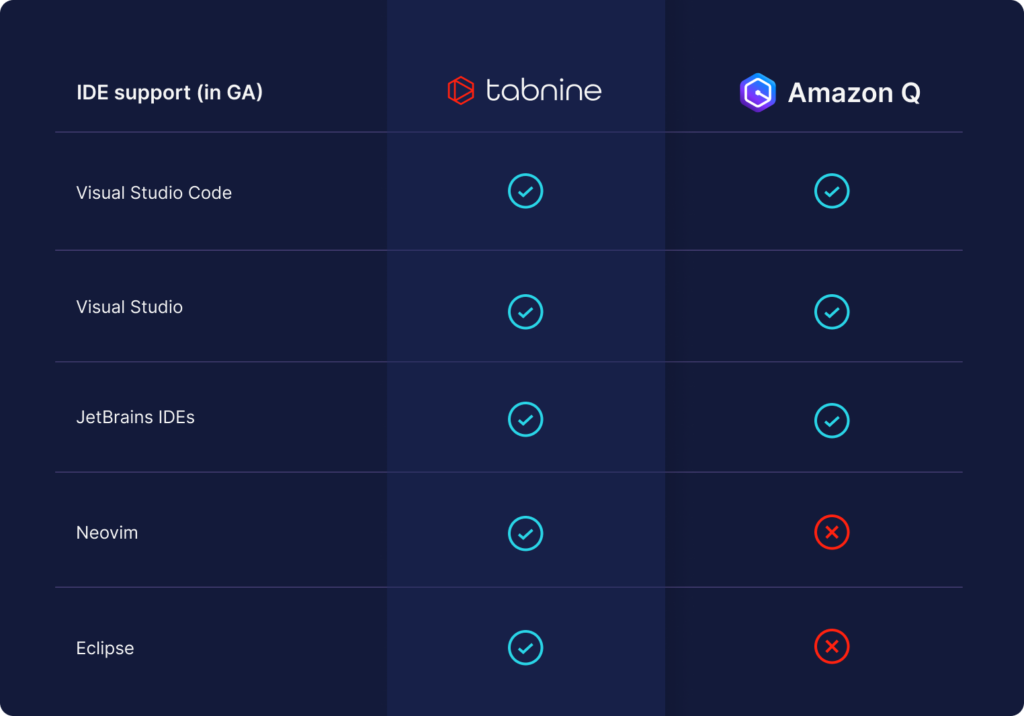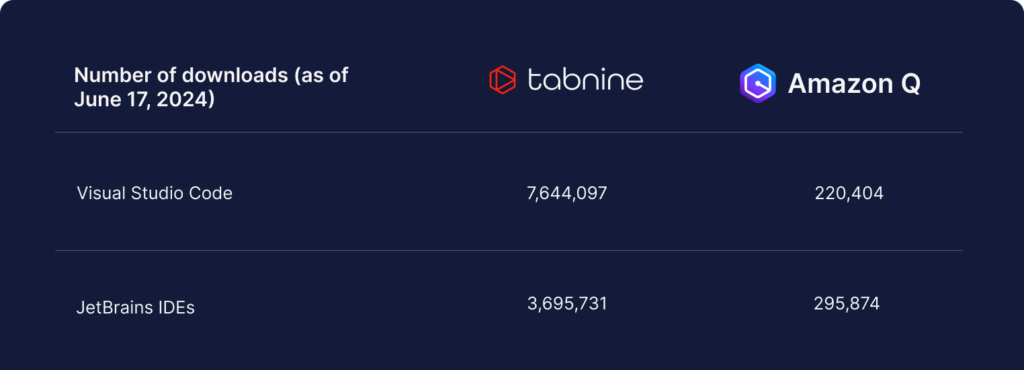Table of contents

Amazon Q Developer (previously called Amazon CodeWhisperer) enables users to understand, build, extend, and operate AWS applications — for example, Q can tell users the Lambda functions running in a specific region or help them understand the costs associated with their AWS services.
Similar to Tabnine, Q Developer is also an AI code assistant. Both products use AI-powered chat and code completions to accelerate the software development life cycle and support common use cases such as planning (i.e., asking general coding questions or better understanding code in an existing project), code generation, explaining code, creating tests, fixing code, creating documentation, and maintaining code.
However Tabnine offers significant advantages over Amazon Q Developer. Unlike Q Developer, Tabnine gives you utmost control over its AI code assistant by allowing customers to personalize the AI to their systems, and set the privacy and protection trade-offs that fit their security and compliance policies:
This blog post goes through each of the differences between these products in detail, demonstrating why we believe that Tabnine is the ideal choice for enterprises and individual developers.
Even though generative AI for software development has become mainstream in the past few years, there’s still a lot of skepticism around code assistants: How does the AI code assistant handle my data? What data set is the underlying model trained on? Will my code be used to train the model? This skepticism has prevented companies from fully embracing AI for their engineering teams. In this section, we’ll cover how Tabnine and Amazon Q Developer address data privacy issues.
Data retention policies
Amazon Q Developer stores your questions, its responses, and additional context, such as code in your IDE to generate responses to your questions. The data from Pro tier users is not used to train the underlying foundational models.
Tabnine takes a completely different approach and offers a zero data retention policy. When using Tabnine’s proprietary models, we don’t store customer code, don’t share customer code or usage data with third parties, and don’t use customer code to train our models.
Deployment options
Amazon Q Developer is offered only as a SaaS product. This is often a deal breaker for privacy-conscious enterprises, especially those in highly regulated environments such as financial services, healthcare, defense, semiconductor, and automotive, as these companies need an air-gapped deployment.
Tabnine offers its customers numerous deployment options. Customers can consume Tabnine as a secure SaaS offering (in a multitenant or single-tenant environment) or do a fully private installation (either on-premises or on VPC) to ensure that their code stays in the boundaries of their corporate network and isn’t shared with any external party.
Amazon Q Developer is built on Amazon Bedrock, a fully managed service for building generative AI applications that offers a choice of high-performing foundation models (FMs) such as Titan, Claude, Mistral, and Llama. Q Developer uses multiple FMs to complete its tasks and uses logic to route tasks to the FM that’s the best fit for the job.
The FMs used by Q Developer are trained using a diverse range of publicly available data, which may include copyrighted code. It’s possible for Amazon Q Developer to generate code that matches publicly available code. If a code suggestion matches proprietary code, there’s risk that using that suggestion could trigger claims of copyright infringement. To mitigate this legal risk, Q Developer offers indemnification for its Pro tier customers. It also provides a reference to the license type and the URL for the publicly available code. The onus is then on the users to review the referenced code and decide whether or not to use it. Also, since Q Developer uses multiple FMs to complete its tasks, it can be difficult for enterprises to determine the attribution of where a specific suggestion came from.
Tabnine eliminates concerns around IP infringement from the get-go. We’ve trained our proprietary models (Tabnine Protected for Chat, and the universal model for code completion) exclusively on permissively licensed code. This ensures that the recommendations from Tabnine never match any proprietary code and removes any concerns around legal risks associated with accepting the code suggestions. Unlike Q Developer, we’re transparent about the data that was used to train our proprietary model and share it with customers under NDA. Additionally, we offer an IP indemnification to Enterprise users for peace of mind.
In AI, context is everything. To increase the effectiveness of AI code assistants, it’s imperative to provide contextual awareness to the LLMs so that they can understand the subtle nuances that make a developer and organization unique.
Amazon Q Developer gains the context by leveraging the locally available information in the developer’s IDE. Additionally, you can connect Q Developer to your data sources containing the company’s code base. (This capability is in preview and is limited to codebases in Java, JavaScript, TypeScript, and Python.) This context enables Q Developer to provide personalized recommendations.
Tabnine leverages locally available data in the developer’s IDE to provide more accurate and relevant results. This includes runtime errors, imported libraries, other open files, current file, compile/syntax errors, noncode sources of information, current selected code, connected repositories, conversation history, Git history, project metadata, and other project files.
Additionally, users can connect Tabnine to their organization code repos (e.g., GitHub, GitLab, and Bitbucket) to gain global context. Tabnine also offers model customization: you can fine-tune our proprietary model using your own code to create a custom model. Model customization is extremely valuable when you have code in a bespoke programming language or a language that’s underrepresented in the training data set, such as System Verilog.
Amazon Q Developer is powered by AWS Bedrok and uses multiple FMs to complete its tasks. However, users don’t have control over choosing a specific model when using Q Developer. This makes it difficult for users to leverage the new and powerful models that become available.
Tabnine currently offers users 8 different model choices for Tabnine Chat: two custom-built, fully private models from Tabnine; Open AI’s GPT-4o, GPT-4.0 Turbo, and GPT-3.5 Turbo Anthropic’s Claude 3 Sonnet model; Cohere’s Command R model, and Codestral, Mistral’s first-ever code model. This flexibility enables users to pick the right model based on their use case or a project. For projects where data privacy and legal risks are less important, you can use a model optimized for performance over compliance. As you switch to working on projects that have stricter requirements for privacy and protection, you can change to a model like Tabnine Protected that’s built for that purpose.
Enterprises have complete control when selecting models that power Tabnine Chat. Tabnine admins can choose any specific models from the list of available LLMs and make them available to their teams. They can also connect Tabnine to an LLM endpoint inside their corporate network if needed.
Many new, powerful LLMs were released in the first half of 2024 alone: OpenAI’s GPT-4o, Anthropic’s Claude 3 models, and Cohere’s Command R+ model, to name a few. At Tabnine, we’re committed to adding support for new, state-of-the-art LLMs as they become available. This prevents LLM lock-in, future-proofs your AI strategy, and enables you to take advantage of all the innovation happening in this space.
IDE support
Tabnine offers much more robust coverage for IDEs compared to Amazon Q Developer.

Programming languages and frameworks
Tabnine supports more than 80 programming languages and frameworks, whereas support for Q Developer is limited to Python, Java, JavaScript, TypeScript, C#, Go, Rust, PHP, Ruby, Kotlin, C, C++, shell scripting, SQL, Scala, JSON, YAML, and HCL programming languages.
User adoption
The adoption for Tabnine is significantly higher than Q Developer based on the number of downloads for IDE plugins.

The Amazon Q Developer Pro Tier costs $19 per user per month. However, there are usage limits even on the Pro tier. For example, the Amazon Q Developer Agent for code transformation has a limit of 4,000 lines of code per month. You’re charged significant overage fees if you exceed these limits. AWS is infamous for its overage fees; often the overage fees spiral out of control and exceed the base cost of using a service. So users have to be judicious when using Amazon Q Developer and make sure their costs are in check.
Tabnine offers two paid tiers: the Pro tier (which is ideal for individuals and small teams and costs $19 per user per month) and the Enterprise tier ($39 per user per month). There are no usage limits on either tier, which makes it easier to use Tabnine and consume its output without keeping a close eye on your costs.
The table below summarizes the differences between Tabnine and Amazon Q Developer. Both products support common use cases such as code generation, creating documentation, generating tests, and more. However, if you need an AI code assistant that gives you complete control over data privacy, deployment options, personalization, protection from IP infringement issues, freedom to choose the right LLM for your use case, flexibility to use Tabnine with any cloud provider, wider coverage for IDEs and programming languages, and no overage fees or usage limits, then you should consider Tabnine.

Tabnine is honored to be recognized in Gartner® Critical Capabilities for AI code assistants, which focused “on 14 critical capabilities that align with the five most common Use Cases in AI-augmented development.” Gartner® evaluated 12 vendors, and here’s how Tabnine ranked.
Tabnine is ranked first for:
Tabnine is ranked second for:
Omdia recognized Tabnine in Omdia’s Market Radar for AI-Assisted Software Development.
Tabnine’s position as a leader in this space was recently reinforced as we were featured as a luminary in Everest Group’s Innovation Watch Assessment for Generative AI Applications in Software Development. Everest Group — a world-renowned research firm that provides strategic insights on IT, business processes, and engineering services — assessed 14 leading providers of generative AI solutions for software development for this report. The assessment framework evaluated each provider on four criteria (Scale, Level of maturity, Partnerships, and Investments) and segmented them into four categories (Luminaries, Fast Followers, Influencers, and Seekers). Tabnine performed exceptionally well in the entire assessment framework and is recognized as a Luminary.

Check out our Docs or contact us to schedule a demo with a product expert. If you want to try it out for yourself today, sign up here to try it free for 90 days.